If you ask about postmodern art, either the answer will leave you confused or unsatisfied.
Speaking from my personal experience, this topic was a bit hard to research.
But here I am with the explanation in the simplest way you can ever look for.
For starters, art in postmodernism is nothing but a later discovery of the modern era.
It came into existence because some artists decided to experiment with new stuff as they were bored of repetitive styles.
They rejected the similar steps followed in art and moved further to seek something unique and extraordinary.
For modernists, “less was more,” but for postmodernists, “less was a bore.”
They were on the hunt for fascinating art that engrossed the viewers and compelled them to ask questions about what exactly they were looking at.
Let’s dig a little deeper to get a clearer picture of what art in postmodernism actually is.
Table of contents
Understanding Postmodern Art Movement (Simple Words)
To understand postmodern art, we first need to know what modernism is.
Modernism was an intellectual movement that started in the 20th century.
In simple terms, it was an art movement that held the idea that the things of the present should be better than the past.
The modernists tried to forge a finer world inspired by scientific facts and universal truths.
But the concept of postmodernists was in reverse.
They did not believe in factual things; instead, they had a perception of developing something exceptional.
Do you remember the famous work of the artist of Dadaism, “Marcel Duchamp?”
His famous dada work, “Fountain,” conveyed a new meaning to the audience.

What is the first thing that comes to mind after looking at this work?
Weird? What is the meaning of this? Is this really art? Who creates such art?
The question raised in your mind is the exact thing that postmodernists wanted their viewers to feel.
Art that crosses the level of extraordinary makes the audience think and wonder.
But I have a thought: Is there a need for postmodernism in art?
Things have started to become interesting, isn’t it?
Keep reading, as the curiosity has just begun!
What is Postmodernism?

The middle of the 20th century came as an outburst for some of the artists.
Modernism was replaced by a new style that didn’t have any guidelines or rules.
The artists had the freedom to express themselves through their paintings and designs.
They created art that held immense meaning but was understood by none.
Postmodern in art brought a complete privilege to an artist’s life.
I would like to break down the definition of “Post-Modernism” for you, nice and slow.
With no definite style or theory, art in postmodernism is introduced as a movement that rejected modernism.
It was said to be progressive as it refused the idea of development in art.
Postmodernists don’t believe in high or low art.
They blurred the differences between fine art and kitsch or vulgar art.
As a result, a mixture of gaudy, commercial, and general art was brought into the picture.
The grand rejection of seeing high and low art as separate, creating an art world where there is no specific genre and painting thoughts directly on canvas, defined the postmodern era.
Popular movements like contemporary art, pop art, neo-expressionist art were refused by the artists.
The term “Postmodernism” surround all the art from the modernist period.
The complexity encompassing postmodern artworks made it incredibly influential.
How about we breakdown it’s attributes to get a clearer meaning about art in postmodernism?
Postmodernism Characteristics in Art
How do we identify postmodern art?
The clear-cut breakdown between fine art and popular art defines postmodernism artworks.
Methods that include collages, montage, bricolage, or assemblage simply define postmodern paintings.
Pioneers of Postmodern Art
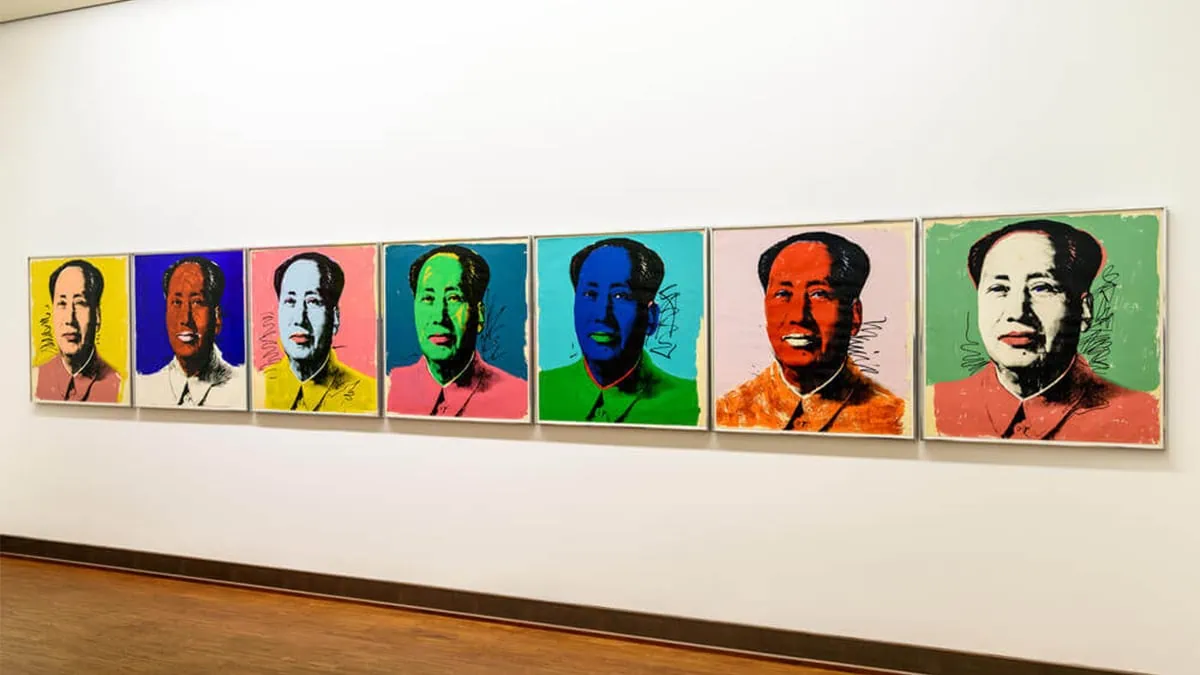
A pioneer? Of course!
As we know, the postmodern art movement is the successor of modern art, but don’t you think it has evolved somewhere?
Each part that molded postmodernist art had its own characteristics.
The precursor of the postmodernist art movement was said to have arisen around the Second World War.
Modernist movements, pop art, and minimalism have gone through various fundamental changes and are counted as the early precursors of postmodern artwork.
You already witnessed the most famous Dada art by Marcel Dupchamp, which was also considered an influential work of art in postmodernism.
Techniques like Cubism, Dada, and Surrealism challenge the present arts.
Despite these pioneers, postmodern art is still considered a shift from modern work.
A brief difference between modernism and postmodernism would be good, right?
Suggested read: In-Depth View on Neoclassical Art
Modern Versus Postmodern Art
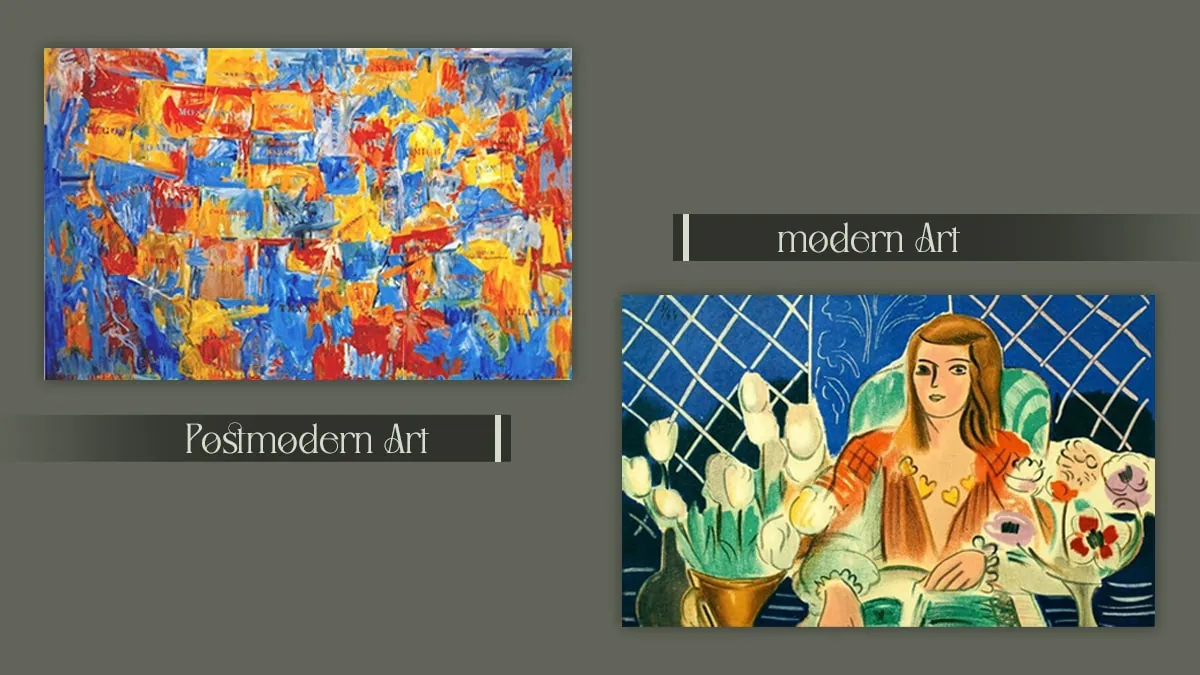
There are not such big differences between art in postmodernism and modernism.
But they are not alike as well.
| Difference | Modernism | Postmodernism |
| Period | Started in late 19th century or early 20th century | Started in late 20th century |
| Influenced from | First World War | Second World War |
| Reasoning | Based on logical thinking to gain knowledge from art | Based on irrational and unscientific process |
| Styles and Art | Techniques like Surrealism, Fauvism, Cubism, and Impressionism were used. | Intentionally uses a mixture of conventional styles |
However, the transformation between these two movements was a major distress.
Modernism Turning into Postmodernism
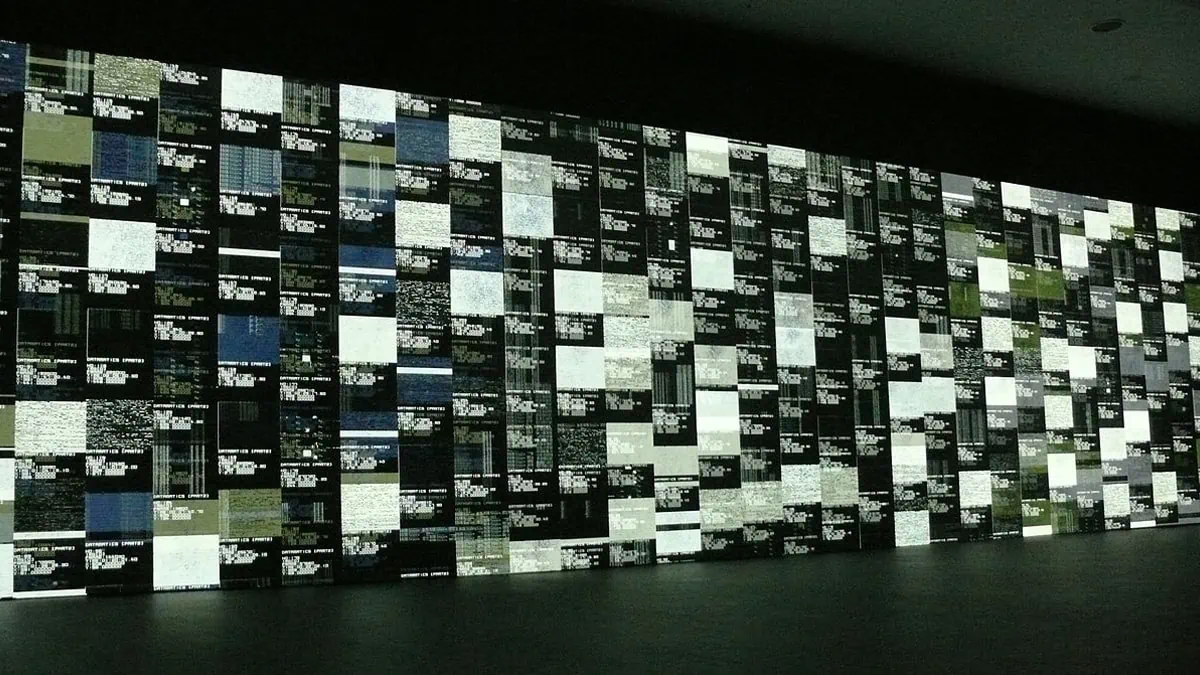
The transition from modern art to postmodern art was marked as a significant change in the Western world.
During the shift of these movements, two destructive wars took place, millions of people lost their lives, communist ideals were damaged and of course nuclear weapons were used.
Additionally, Europe was no longer viewed as the avant-garde of modern art.
The focus was shifted to New York, where the abstraction of art was developing at a rapid pace.
Artists creating works within this movement grew interested when a new post-war era of art took place.
New meanings and features were taking space, along with some brilliant works that shouldn’t be missed.
Shall we take a look at some examples of postmodernism art?
Famous Postmodern Artists and Their Masterpieces
Here I’ve added some famous postmodern artists and their fabulous works.
Let’s dive into this mini-art gallery!
1. Crying Girl by Roy Lichtenstein
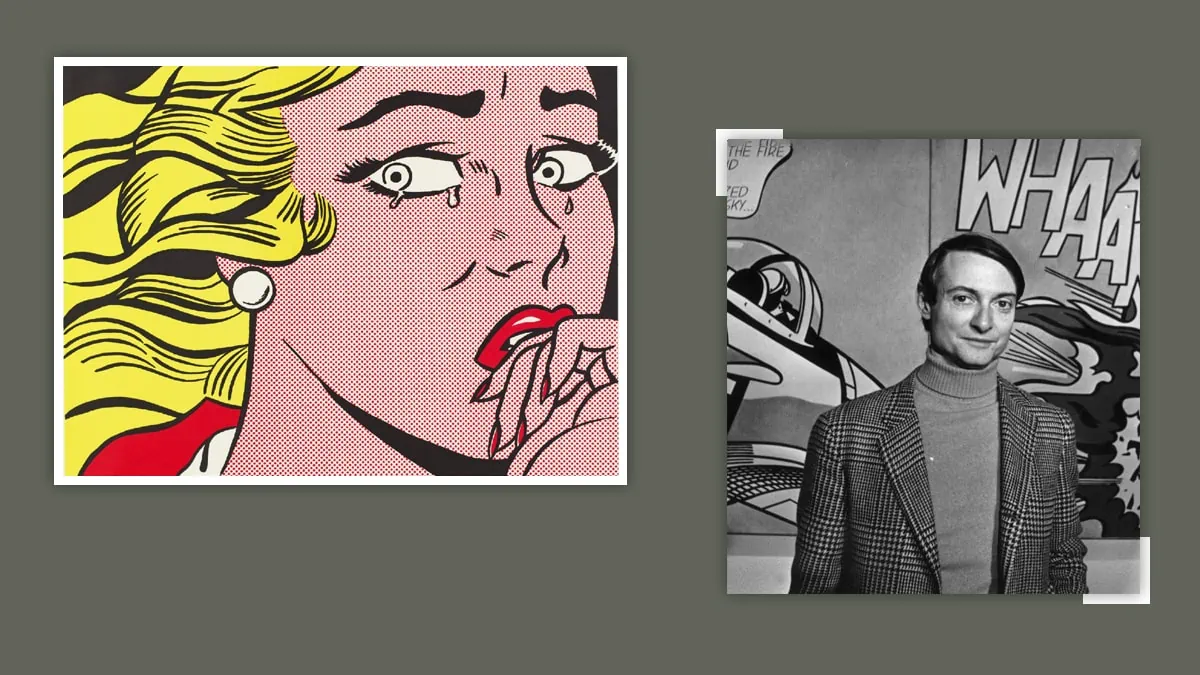
You must have seen this painting before.
“Crying Girl” is taken from a comic named “Secret Hearts.”
It’s a pop-style print with thick lines and plain surfaces and known among the most famous postmodern artwork examples.
Lichtenstein produced numerous “fantasy dramas” that incorporated women.
His pattern in art depicts women in miserable positions caused by domineering men.
Roy portrayed elements of contemporary art and popular print in his works.
In 1961, Roy began to replicate Benday’s comics, billboards, and newspapers.
By mimicking this technique, he blurred the difference between high and low art.
2. Untitled (I shop therefore I am) by Barbara Kruger

Here’s another iconic postmodern piece of art by Barbara Kruger.
This artwork was reproduced on different consumer products, such as t-shirts, shopping bags, and more.
Kruger often extracts things from mass media and brings them into existence to advertise.
Do you know the meaning behind “I shop Therefore I am?”
This catchphrase is borrowed from a French philosopher, René Descartes.
He once said, “I think, Therefore I am.”
The phrase speaks about your existence as a human.
People are shopping or doing any kind of activity, which means it’s proof that they exist.
It’s beautiful, right?
3. Marilyn Diptych (1962) by Andy Warhol

Repetition in art was a major style used during the postmodernist period.
If you ask what is postmodern art, then Andy Warhol’s works can be at the top of the list.
What you are witnessing above is a painting of an actor who died of a drug overdose in 1962.
Warhol used her publicity picture to create his masterpiece.
The contrast of Marilyn Diptych depicts two sides of her life: fame and her private self.
Andy was known as one of the most famous American artists.
The idea of portraying the two lives of the actress was not intentional.
The work received a tremendous amount of praise from different writers. It was a hit!
4. Collection by Rauschenberg
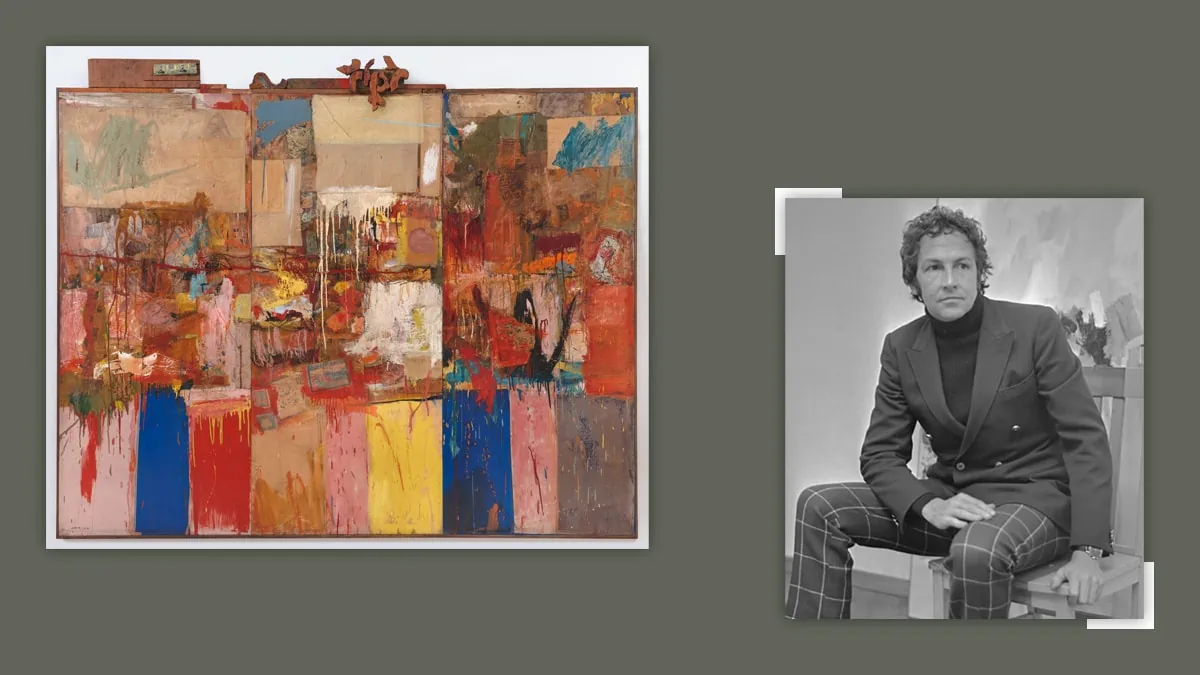
Collection? I don’t see any collection in this artwork. Do you?
Robert Rauschenberg gave this masterpiece the title “Collection,” as it’s a first-combined painting.
It hangs on the wall as a traditional painting but can be divided into three dimensions with various elements.
It is neither a sculpture nor can we call it a painting.
Robert describes the art piece as a series of works that he began in 1954 to avoid traditional art media.
It is a new approach to color, as Rauschenberg experimented with various shades other than monochrome.
I guess we can also interpret the title name as “Collection,” as it is a combination of various hues.
Brilliant work by Mr. Robert!
Suggested read: Descriptive Guide to Figurative art
5. Untitled #153 by Cindy Sherman

Untitled #153 is one of the most expensive photographs, selling for 2.7 million dollars in 2010.
The photograph is part of a series called Vanity Fair that is inspired by fairy tales.
If you notice, the self-portrait gives a bit of a petrified appearance, giving a new postmodern art definition.
A dead woman with her eyes open lies on the ground as a corpse.
Cindy Sherman created a dark and grotesque piece that gives off a doll look.
Don’t you feel as if it is similar to a crime scene photo?
Although it is way different than a police photograph, the picture illuminates bold, glossy art and a woman with a waxy face.
One of the most beautiful works, for sure!
I wonder how amazing it will appear on walls. It would definitely give an aesthetic and vibrant look to your abode.
Get a reproduction painting at affordable prices with just one click!
Concluding with the Legacy of Postmodern Art
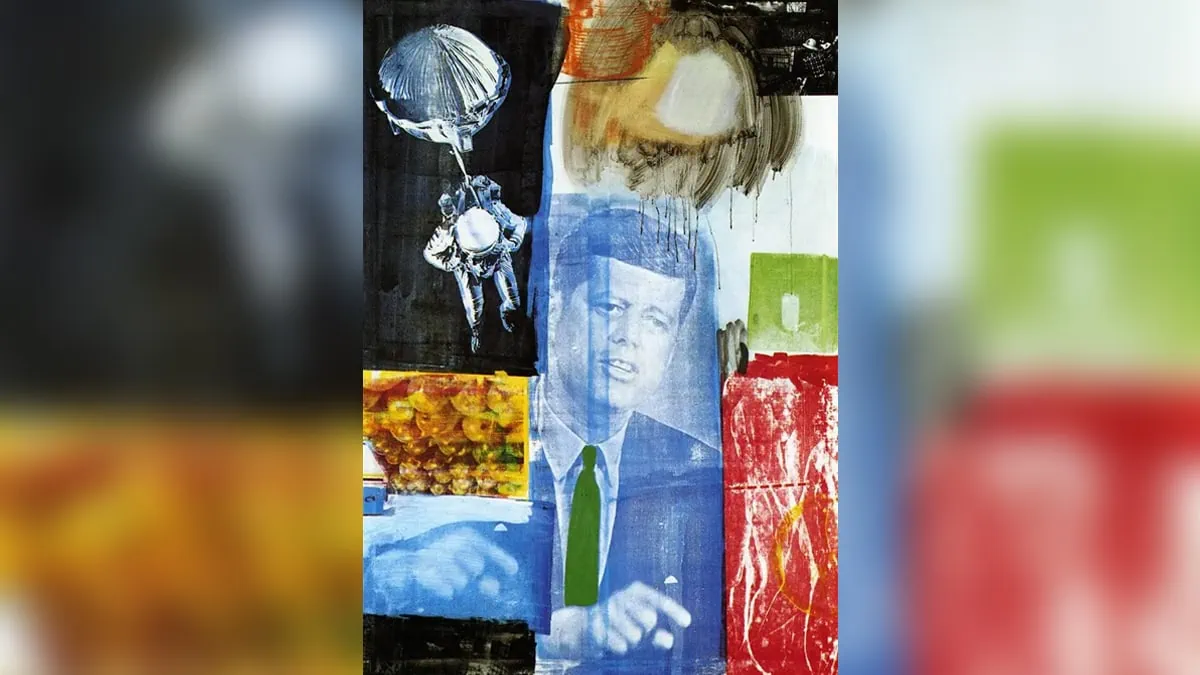
Everyone still wonders what postmodernism is.
As postmodernism’s paintings don’t have a definite meaning, it is a bit difficult to determine what exactly they mean.
If you are still having a hard time remembering the meaning, then just simply recall “anything that goes with the trend.”
From my point of view, every new piece of art is a postmodern work.
Postmodern art is looked upon as a disruptive movement for modernists.
However, it also enabled the continuation of modernist art, including different styles.
It brought a huge change to the artistic society and collaborated with various art movements.
How amazing it is that a precursor to existing art brings tremendous value to the art world.
In today’s time, elements of postmodern art are still borrowed from different art styles.
How You Doing Readers?
I know that learning about art movements may make you yawn.
With this thought, I have made my writing interesting to read and tried to answer all the queries that may occur to you while going through the topic.
I hope you enjoyed the blog and gained all the information you were looking for.
If you have any questions to ask or suggestions to give, please let me know via comments.
I would like to know about the art movement from different perspectives.
I’ll be back with my next piece soon.
Till then, keep reading and exploring. Have a great day!
FAQs
Parody, humor, and irony are some of the themes that describe postmodern art.
Juxtaposition, Appropriation, Layering, Hybridity, Interaction of Text and Image, Recontextualization, Gazing, and Representation are the seven principles of postmodern art.
Moore was known as the father of postmodernism.
The painting Marilyn Diptych (1962) by Andy Warhol is one of the most popular examples of postmodern art.




